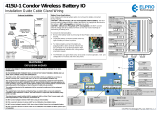
115S Serial I/O Module User Manual
Page 4 June 2011
CONTENTS
1
OVERVIEW................................................................................................................ 5
1.1 M
ODULE TYPES AND FEATURES
.................................................................................... 7
1.1.1 Digital inputs / outputs ........................................................................................ 7
1.1.2 Pulsed outputs ..................................................................................................... 7
1.1.3 Pulsed inputs....................................................................................................... 8
1.1.4 Analog inputs ..................................................................................................... 8
1.1.5 Analog outputs .................................................................................................... 9
1.1.6 Communications ............................................................................................... 10
2
INSTALLATION...................................................................................................... 11
2.1 G
ENERAL INSTALLATION
............................................................................................ 11
2.1.1 Power Connection ............................................................................................. 11
2.1.2 Address Switches .............................................................................................. 12
2.2 S
IGNAL
C
ONNECTIONS
................................................................................................ 13
2.2.1 Digital Inputs (and Pulsed Inputs) ..................................................................... 13
2.2.2 Digital Outputs (and Pulsed Outputs) ................................................................ 14
2.2.3 Analog Inputs ................................................................................................... 14
2.2.4 Analog Outputs ................................................................................................. 18
3
CONFIGURATION ................................................................................................. 21
3.1 ELPRO
E
XPANSION
I/O
CONFIGURATION
. .................................................................. 21
3.2 MODBUS
S
LAVE
C
ONFIGURATION
............................................................................ 23
4
HARDWARE CONFIGURATION ........................................................................ 24
4.1 C
ONNECTING TO THE
115S
MODULE
........................................................................... 24
4.2 C
ONFIGURATION COMMON TO ALL MODULES
.............................................................. 25
4.2.1 Communications ............................................................................................... 25
4.2.2 Modbus Output Timeout on Comms fail ........................................................... 26
4.2.3 Configurable ACK Timeout .............................................................................. 27
4.2.4 Pulsed outputs ................................................................................................... 28
4.3 115S-11
CONFIGURATION
........................................................................................... 29
4.3.1 Pulsed Inputs .................................................................................................... 29
4.4 115S-12
CONFIGURATION
........................................................................................... 30
4.4.1 Voltage input .................................................................................................... 30
4.4.2 Current input ..................................................................................................... 33
4.5 115S-13
CONFIGURATION
........................................................................................... 36
4.5.1 Voltage output .................................................................................................. 36
4.5.2 Current output ................................................................................................... 38
5
OPERATION ............................................................................................................ 40
5.1 115S-11
MODULE
........................................................................................................ 40
5.2 115S-12
MODULE
........................................................................................................ 41
5.3 115S-13
MODULE
........................................................................................................ 43
5.4 H
EXADECIMAL REPRESENTATION OF VOLTAGE AND CURRENT LEVELS
........................ 45
APPENDIX A. MODBUS ADDRESS MAP ................................................................. 46
A.1.
115S-11 ......................................................................................................................... 46
A.2.
115S-12 ......................................................................................................................... 48
A.3.
115S-13 ......................................................................................................................... 50
APPENDIX B. MODBUS FUNCTIONALITY ............................................................ 52
APPENDIX C. COMMS RECOVERY ......................................................................... 53

























